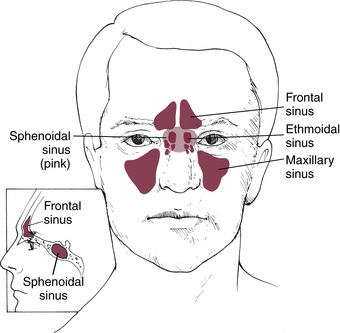CHAPTER 22 Nasal symptoms and sinus congestion
The paranasal sinuses include the frontal, ethmoid, maxillary, and sphenoid (Figure 22-1). Most sinus infections are caused by bacteria common to the nasopharynx that proliferate when local or systemic defenses are impaired. The most common causative organisms producing bacterial sinusitis in both adults and children are Streptococcus pneumoniae and Haemophilus influenzae. Sinusitis may also be associated with allergies and asthmatic exacerbations or with contiguous infection of the mouth or face.

FIGURE 22-1 Anterior and lateral views of the paranasal sinuses.
(From Barkauskas VH, Baumann L, Darling-Fisher C: Health and physical assessment, ed 3, St Louis, 2002, Mosby.)
Diagnostic reasoning: focused history
Seasonal occurrence of symptoms
Persons with perennial allergies have an allergen present in the environment on a year-round basis from such sources as animal dander, house dust, mold, feathers, and cockroaches. Seasonal allergies usually occur in early spring (tree pollens), early summer (grass pollens), and early fall (weed pollens).
Other acute symptoms
Acute bacterial infection of the nasal and sinus mucosa is characterized by the presence of purulent nasal discharge. Acute rhinitis caused by a bacterial or viral infection produces systemic symptoms, such as fever, myalgia, and chills. Allergic rhinitis is associated with sneezing, nasal congestion, clear and profuse rhinorrhea, and pruritus of the nose, palate, pharynx, and middle ear. Eye complaints include conjunctival irritation, itching, erythema, and tearing. Ear complaints involve a feeling of fullness in the ears with popping. Sinus complaints are pressure and/or pain of the cheeks, forehead, or behind the eyes.
Chronic symptoms
Are there risk factors that will narrow the diagnosis?
Key questions
Stay updated, free articles. Join our Telegram channel

Full access? Get Clinical Tree























